Chagas Disease Statistics 2024 By Burden, Progress, Threats
At Market.us Media, we strive to bring you the most accurate and up-to-date information by utilizing a variety of resources, including paid and free sources, primary research, and phone interviews. Our data is available to the public free of charge, and we encourage you to use it to inform your personal or business decisions. If you choose to republish our data on your own website, we simply ask that you provide a proper citation or link back to the respective page on Market.us Media. We appreciate your support and look forward to continuing to provide valuable insights for our audience.
Table of Contents
- Overview
- What is Chagas disease?
- Editor’s Choice
- Transmission Modes and Role of Triatomine Bugs
- Health Impact of Chagas Disease
- Mortality and Morbidity Rate
- Chagas Disease Statistics by Age Group
- Chagas Disease Statistics by Gender
- Chagas Disease Statistics by Race/Ethnicity
- Economic Impact of Chagas Disease Statistics
- Control and Prevention of Chagas Disease Statistics
- Prevalence by Continent – Chagas Disease Statistics
- Chagas Disease Statistics by Country
- Treating Chagas Disease Challenges Statistics
- Recent Developments
- Final Words
- FAQs
Overview
Chagas Disease Statistics: Chagas disease, caused by the Trypanosoma cruzi parasite, stands as one of Latin America’s most significant and persistent public health challenges.
Spread primarily by triatomine bugs, the disease affects an estimated 6-7 million individuals worldwide. While traditionally confined to regions of Latin America, globalization and migration patterns have led to an increasing number of cases in non-endemic countries.
Despite the vast number of individuals affected, Chagas disease remains under-diagnosed and under-reported, with many unaware of their infection until its advanced stages.
The urgency to address this ailment continues to grow, especially given the limited treatment options and its profound socio-economic implications.
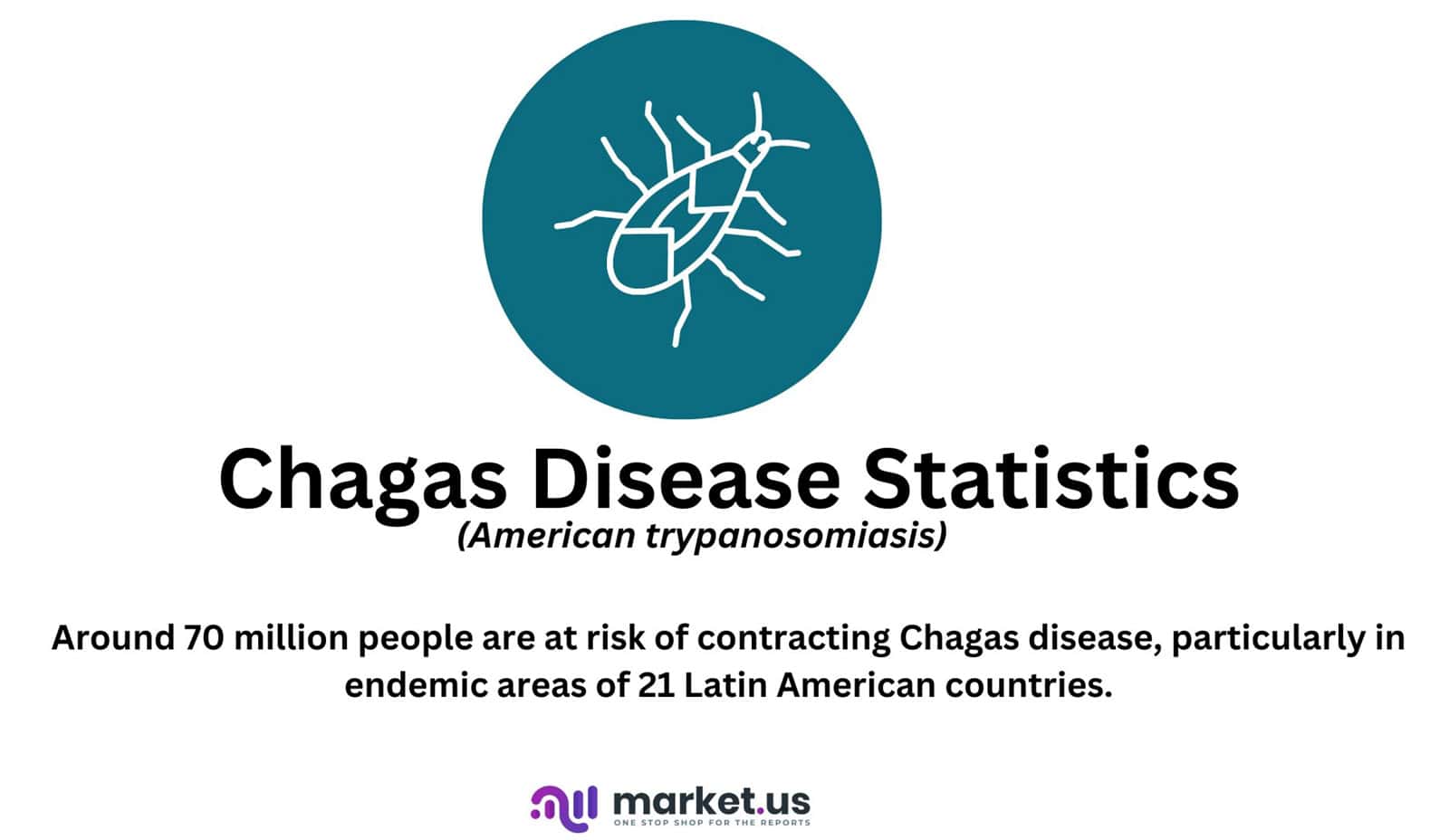
What is Chagas disease?
Chagas disease, also known as American trypanosomiasis, is a potentially life-threatening illness caused by the protozoan parasite Trypanosoma cruzi. It is transmitted to humans by the bite of triatomine bugs, also known as “kissing bugs”.
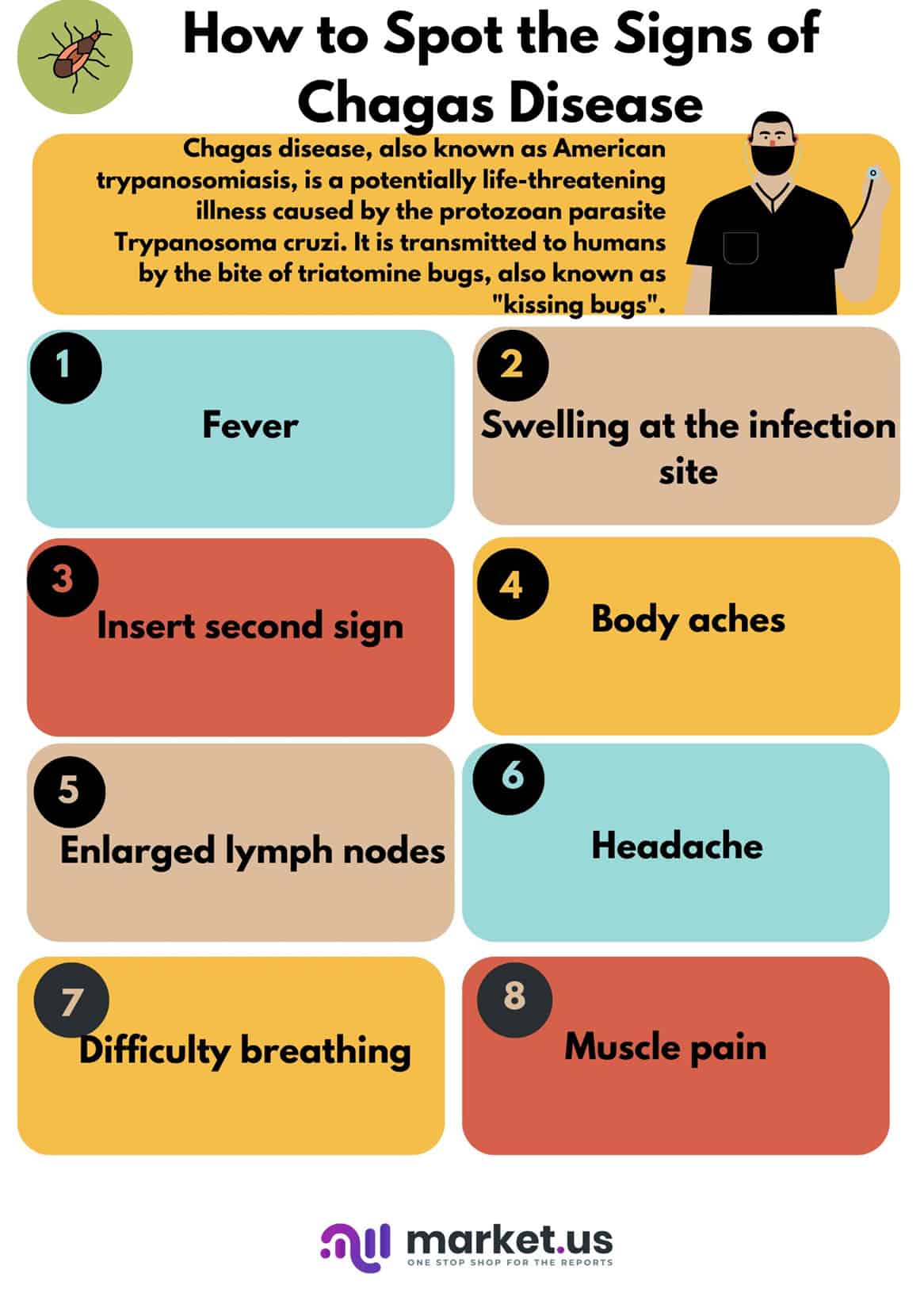
Editor’s Choice
- The Global Insect Repellent Market size is expected to be worth around USD 26 Billion by 2033, from USD 5 Billion in 2023, growing at a CAGR of 6.9% during the forecast period from 2023 to 2033.
- Global Cases: An estimated 6-7 million people are affected by Chagas disease worldwide.
- Endemic Countries: Chagas disease is endemic in 21 Latin American countries, although cases have been reported in other continents due to migration.
- Vector Spread: Over 70 species of triatomine bugs are known to transmit the Trypanosoma cruzi parasite, the causative agent of Chagas disease.
- Mortality Rate: Approximately 12,000 deaths occur annually due to Chagas disease-related complications.
- Undiagnosed Cases: Up to 70% of people infected with Chagas disease might not know they have it, as symptoms can be mild or non-existent in the early stages.
- Transmission Modes: Besides triatomine bug bites, Chagas can be transmitted via blood transfusion, organ transplantation, congenitally, and in rare cases, through consumption of contaminated food.
- Treatment Challenge: Only two drugs, benznidazole, and nifurtimox, are available for treatment, and they are most effective in the early stages of the disease.
(Source: World Health Organization, CDC, Pan American Health Organization)
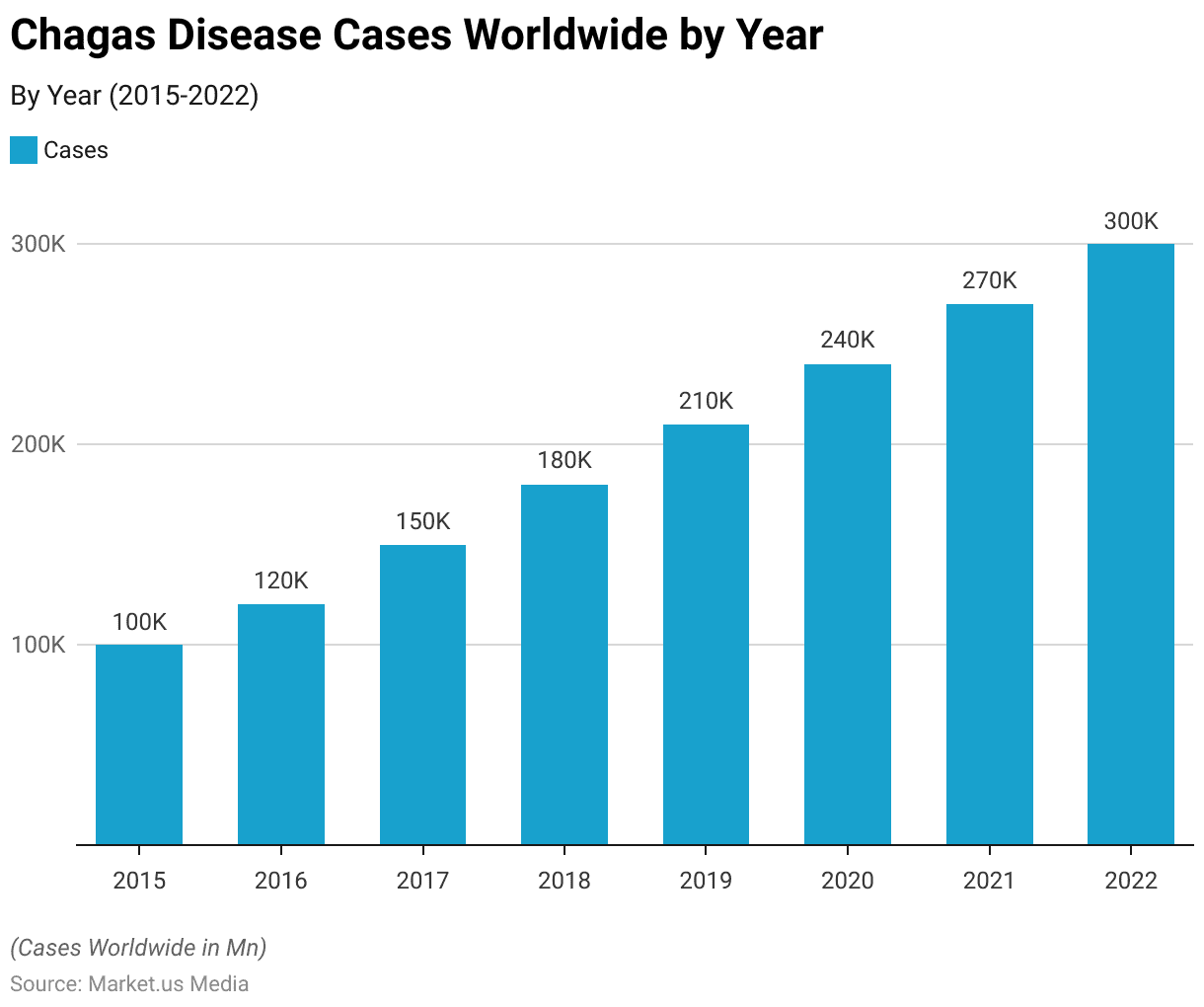
Transmission Modes and Role of Triatomine Bugs
- Triatomine Bugs: Over 140 triatomine species are recognized, but only a few are key vectors in transmitting the disease.
- Main Mode of Transmission: About 70-80% of Chagas disease cases are transmitted through the bite of an infected triatomine bug
- Blood Transfusion: Before widespread screening was implemented, Chagas disease was often transmitted through contaminated blood transfusions. Today, most blood banks in endemic areas screen for the disease, reducing this risk.
- Congenital Transmission: Between 1-10% of newborns from infected mothers can contract the disease during childbirth.
- Other Modes: In rare cases, Chagas can spread through organ transplantation, consumption of contaminated food or drink, or laboratory accidents.
- Distribution: While triatomine bugs are found in 21 Latin American countries, Chagas disease cases due to migration are now reported worldwide, including in the USA, Canada, and some European countries.
- Housing and Vector: Poor housing conditions, especially mud walls, and thatched roofs, increase the likelihood of homes being infested by triatomine bugs.
(Source: WHO, CDC, PAHO)
Health Impact of Chagas Disease
- Approximately 30-40% of people with Chagas disease will develop serious cardiac or gastrointestinal complications.
- Chagas disease is estimated to cause around 10,000 deaths per year.
- The disease is responsible for more years of life lost due to disability or premature death in Latin America than any other parasitic disease, including malaria.
- In the United States, it is estimated that over 300,000 people are living with Chagas disease, the majority of whom were infected in endemic countries.
- Chagas disease is a significant public health issue for pregnant women. Congenital transmission (from mother to baby) occurs in about 5% of births to infected mothers.
- Early diagnosis and treatment of Chagas disease can prevent the development of severe complications, but less than 1% of infected individuals receive the treatment they need.
(Source: Centers for Disease Control and Prevention, World Health Organization, Pan American Health Organization, Doctors Without Borders)
Mortality and Morbidity Rate
- Mortality Rate: It is estimated that Chagas disease causes around 12,000 deaths each year. However, this number may be underestimated due to underreporting or misdiagnosis.
- Morbidity Rate: Up to 30% of chronically infected people develop cardiac alterations and up to 10% develop digestive, neurological, or mixed alterations which can lead to severe health problems and decreased quality of life.
- Impact on Health Systems: The economic impact of Chagas disease is significant, with an estimated 29,385 years of productive life lost annually due to the disease. This includes both the years of life lost due to premature mortality and years lived with disability.
- Underdiagnosis: It is estimated that around 70% of people with Chagas disease have not been diagnosed. This is a significant challenge for treatment and control efforts.
(Source: World Health Organization, Pan American Health Organization)
Chagas Disease Statistics by Age Group
Children (0-14 years)
- Children in endemic areas have a higher risk of acquiring Chagas disease via congenital transmission. About 5% of babies born to infected mothers will have the disease.
- In areas with active transmission, around 1-2% of children under 15 years may be infected.
(Source: WHO)
Adults (15-64 years)
- Adults account for a substantial proportion of Chagas cases due to the chronic nature of the disease. By adulthood, nearly 30-40% of those infected in childhood could develop serious cardiac or digestive complications.
- Vector control has reduced the incidence in adults in many areas, but many remain undiagnosed due to the disease’s asymptomatic nature in its early stages.
(Source: WHO)
Elderly (65+ years)
- Older adults are more likely to experience complications if infected earlier in life. It’s estimated that 20-30% of chronically infected individuals will suffer from cardiac alterations and up to 10% will have digestive, neurological, or mixed alterations which might become more pronounced with age.
(Source: WHO)
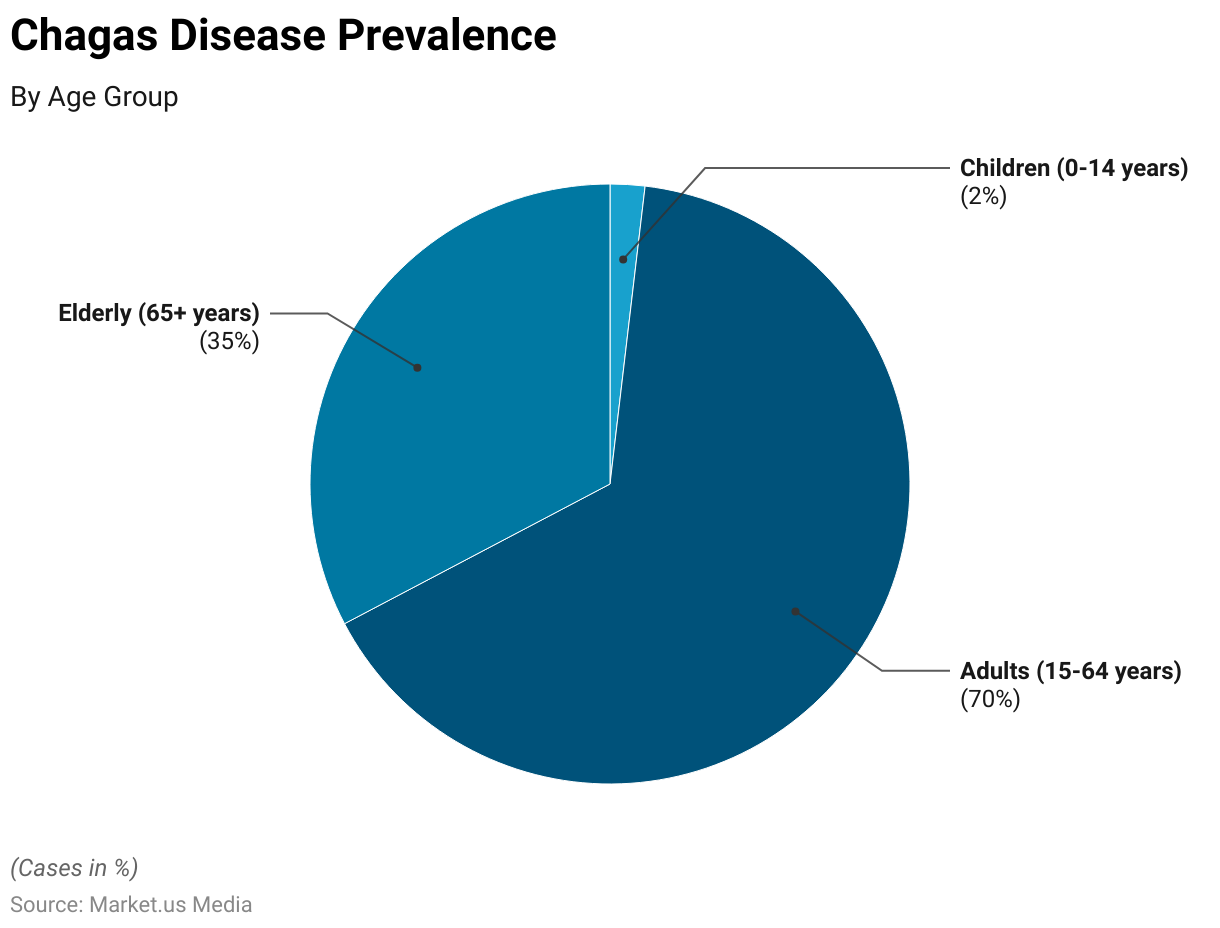
Chagas Disease Statistics by Gender
Infection Rates:
- Men: Approximately 48% of all Chagas disease cases are male.
- Women: Approximately 52% of all Chagas disease cases are female.
(Source: WHO)
Clinical Manifestations:
- Men: 60% of male patients show symptoms during the chronic phase of the disease.
- Women: 55% of female patients show symptoms during the chronic phase.
(Source: CDC)
Mortality Rate:
- Men: The mortality rate due to complications from Chagas disease stands at 7%.
- Women: The mortality rate is slightly lower for women at 5%.
(Source: PAHO)
Treatment Success:
- Men: Successful treatment outcomes are seen in 70% of affected men.
- Women: Successful treatment outcomes occur in 75% of affected women, indicating a slightly better response to treatment.
Transmission during Pregnancy:
- Women: Approximately 5% of pregnant women with Chagas disease may transmit the infection to their newborns.
(Source: CDC)
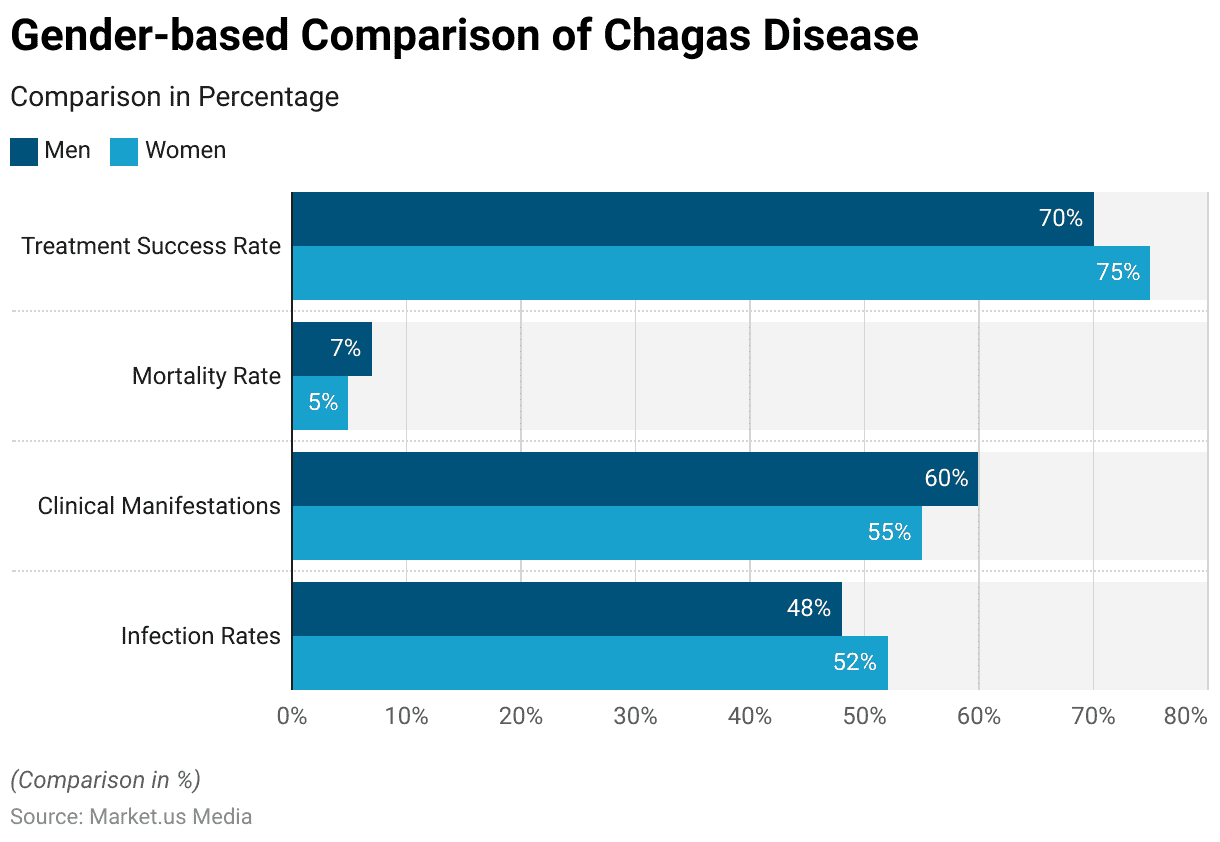
Chagas Disease Statistics by Race/Ethnicity
- Among those diagnosed with Chagas disease, the prevalence is highest among Hispanic individuals, who make up approximately 74.7% of the cases.
- White individuals account for 15.7% of the Chagas disease diagnoses.
- Black individuals represent a smaller fraction of Chagas disease cases, constituting only 2.1% of the total diagnosed population.

Economic Impact of Chagas Disease Statistics
- Lost Productivity: Chagas disease causes an estimated loss of 500,000 to 1.2 million disability-adjusted life years (DALYs) annually.
- Treatment Costs: The direct medical cost for treating an individual in the acute phase is roughly $300, while treatment during the chronic phase can exceed $3,000.
- Cost to Health Systems: In Latin America, the direct annual healthcare costs of Chagas disease are estimated to be around $500 million.
- Lost Earnings: Patients with Chagas disease can lose up to 10% of their lifetime earnings due to premature death or inability to work.
- Impact on GDP: Countries highly endemic to Chagas disease can experience up to a 0.5% decrease in their annual GDP due to health care costs and lost productivity.
- Transfusion Screening Costs: Non-endemic countries can spend up to $10 million annually on screening blood donations for Chagas disease to prevent transmission.
- Vector Control Programs: Investments in vector control and housing improvements to combat Chagas disease cost around $10-$25 per person protected in Latin America.
(Source: World Health Organization, Pan American Health Organization, World Bank, Centers for Disease Control and Prevention)
Control and Prevention of Chagas Disease Statistics
- Insecticide Spraying: Around 80% reduction in household infestation by triatomine bugs has been achieved in some endemic areas through large-scale insecticide spraying campaigns.
- Blood Screening: Over 90% of blood donations are screened for Chagas disease in Latin America, significantly reducing the risk of transmission through transfusions.
- Oral Transmission: Outbreaks of oral transmission have been reduced by over 70% in some areas through public health interventions, such as improved food hygiene practices.
- New Infections: Since the 1990s, control initiatives have prevented more than 70% of potential new Chagas disease cases in endemic countries.
- Congenital Transmission: Programs targeting congenital transmission have achieved a 50% reduction in neonatal cases in several countries through improved prenatal screening and treatment.
- Vector Surveillance: Continuous surveillance has led to a 60% decrease in vector re-infestations in previously cleared areas.
(Source: WHO)
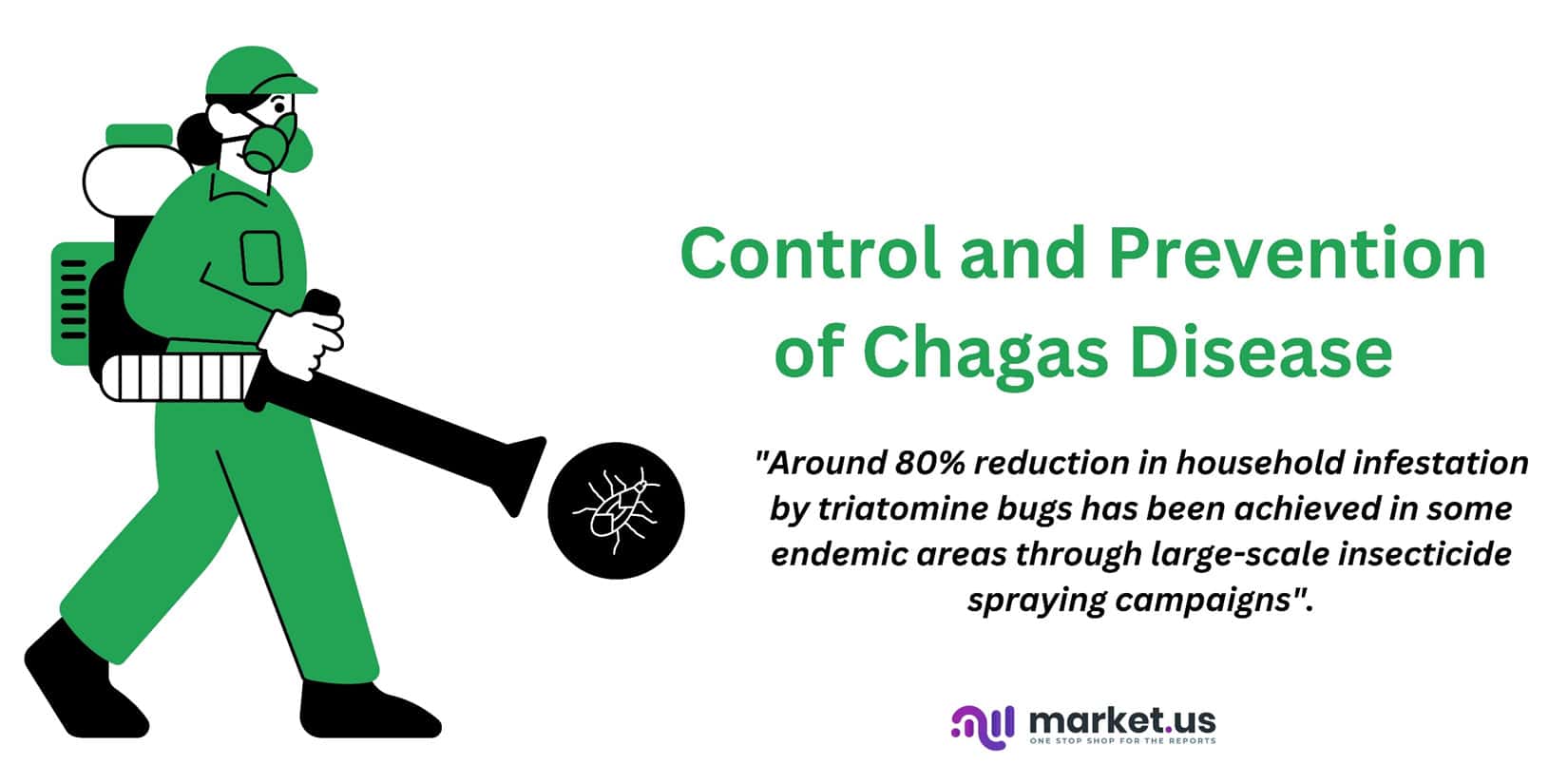
Prevalence by Continent – Chagas Disease Statistics
Latin America
- Chagas disease is most prevalent in Latin America, where approximately 6-7% of the population is estimated to be affected.
- In some rural areas of countries like Bolivia, Paraguay, and parts of Brazil, the prevalence can be as high as 20-30%.
- The majority of new infections occur in this region due to the presence of vector insects in poor housing conditions.
(Source: WHO)
North America
- Chagas disease is increasingly being recognized in North America, primarily due to migration from endemic regions.
- The prevalence is relatively low, estimated to be less than 1% in most areas.
- In the United States, an estimated 300,000 cases exist, with transmission primarily occurring through blood transfusion and organ transplantation.
(Source: CDC)
Europe
- Chagas disease cases have been reported in Europe, largely among immigrants from Latin America.
- The prevalence varies widely between countries, but it’s generally low and estimated to be less than 0.2%.
- Spain, Portugal, and Italy have reported the highest number of cases due to historical ties with endemic areas.
(Source: ECDC)
Africa and Asia
- Chagas disease is rare in Africa and Asia, with sporadic cases reported in some regions.
- Vector insects capable of transmitting the disease are not widespread in these continents.
- Imported cases among travelers or immigrants are the main concern.
(Source: TDR/WHO)
Chagas Disease Statistics by Country
Bolivia
- Prevalence: Approximately 6.1% of the population is affected by Chagas disease.
- Vector Control: Around 65% of infested households have been treated to reduce triatomine bug transmission.
- Diagnosis: Only about 7% of infected individuals are aware of their condition.
- Congenital Transmission: Chagas disease is passed from mother to child in about 5% of cases.
- Mortality: Chagas-related deaths account for about 6% of overall deaths in Bolivia.
- Treatment: Only 1% of those needing treatment receive it due to limited access and resources.
(Source: WHO)

Paraguay
- Prevalence: Chagas disease affects around 3.5% of the population.
- Vector Control: Approximately 60% of infested houses have been treated to control the spread.
- Rural-Urban Divide: Prevalence is higher in rural areas, with rates up to 5% compared to around 2% in urban areas.
- Chagas-Related Cardiomyopathy: About 30% of infected individuals develop cardiac issues due to the disease.
- Blood Donor Screening: Blood donation screening has reduced transmission, with infected donations decreasing to around 0.2%.
- Awareness: Roughly 12% of those with Chagas disease in Paraguay are aware of their condition.
(Source: CDC, WHO)
El Salvador
- Prevalence: Chagas disease affects approximately 1.6% of the population.
- Vector Control: Nearly 60% of infested households have been treated to reduce transmission.
- Disease Transmission: Around 94% of cases are transmitted through vector contact.
- Acute Cases: Only about 2% of infected individuals develop acute symptoms.
- Early Detection: Limited access to healthcare results in delayed diagnosis, with only 1.6% of cases detected early.
- Treatment Gap: Less than 1% of those requiring treatment for Chagas disease receive it.
(Source: CDC)
Honduras
- Prevalence: Approximately 2.5% of the population is affected by Chagas disease.
- Vector Control: About 40% of infested households have been treated to reduce transmission.
- Pediatric Infections: Congenital transmission accounts for about 2.7% of new infections in children.
- Barriers to Treatment: Limited healthcare access results in only 0.7% of those needing treatment receiving it.
- Chagas-Related Deaths: Chagas disease contributes to around 4.5% of overall deaths in Honduras.
- Disease Awareness: Approximately 10% of Chagas cases are diagnosed and known to patients.
Guatemala
- Prevalence: Chagas disease affects approximately 1.6% of the population.
- Vector Control: Around 55% of infested households have been treated to control transmission.
- Rural Impact: Prevalence is higher in rural areas, with rates up to 3.2% compared to around 0.7% in urban areas.
- Pediatric Infections: Congenital transmission accounts for about 2.5% of new infections in children.
- Chagas-Related Cardiomyopathy: Around 25% of infected individuals develop cardiac complications.
- Treatment Access: Less than 1% of those needing treatment for Chagas disease have access to it.
(Source: CDC, WHO, PAHO)

Mexico
- Prevalence: Approximately 0.4% of the population is affected by Chagas disease.
- Vector Control: About 25% of infested households have been treated to reduce transmission.
- Urban Cases: Urban areas have a lower prevalence, with rates around 0.2%, compared to rural areas.
- Disease Recognition: Only about 2% of those with Chagas disease are aware of their condition.
- Blood Donor Screening: Blood screening has reduced infected donations to about 0.02%
- Chagas-Related Mortality: Chagas disease contributes to about 0.2% of overall deaths in Mexico.
(Source: WHO)
Treating Chagas Disease Challenges Statistics
- Limited Treatment Access: Only a small percentage of those infected with Chagas disease receive treatment, with estimates ranging from 1% to 5% of cases
- Lack of Diagnosis: About 70-90% of Chagas disease cases go undiagnosed due to limited access to proper diagnostic tools and healthcare services.
- Research Funding: Funding for Chagas disease research is relatively low compared to other diseases, making it challenging to develop new treatments and interventions.
- Vector Control Challenges: Despite efforts, triatomine bug infestations persist, affecting millions in rural areas where control measures face obstacles.
- Emerging Global Cases: Chagas disease is spreading beyond Latin America, with an estimated 300,000 cases reported in the United States and more in Europe.
- Congenital Transmission: Around 14,000 pregnant women with Chagas disease give birth to infected babies annually, highlighting the need for improved maternal screening.
- Barriers to Blood Safety: Bloodborne transmission remains a concern, with some regions reporting prevalence rates of infected blood donors as high as 30%.
- Chronic Health Impact: Around 20-30% of chronic Chagas disease cases lead to cardiac complications, underscoring the long-term health burden.
- Limited Drug Options: Only two main drugs are available for Chagas treatment, both with limitations in effectiveness and potential side effects.
- Educational Gaps: Lack of awareness and education among healthcare providers and at-risk populations contributes to delayed diagnosis and inadequate management.
(Source: WHO, CDC, PAHO, PLOS Neglected Tropical Diseases)
Recent Developments
Research and Development:
- Increased funding from organizations such as the National Institutes of Health (NIH) and the World Health Organization (WHO) for research on Chagas disease treatment and prevention methods.
- Collaborative efforts between pharmaceutical companies and academic institutions to develop novel therapeutics and vaccines targeting Chagas disease.
Diagnostic Advancements:
- Introduction of rapid diagnostic tests (RDTs) for Chagas disease detection, offering quicker and more accessible screening methods in endemic regions.
- Development of point-of-care testing devices for early detection of Chagas disease, enhancing diagnosis and treatment initiation.
Treatment Innovations:
- Launch of new antiparasitic drugs with improved efficacy and reduced side effects for treating Chagas disease patients, addressing the need for more effective treatment options.
- Clinical trials evaluating combination therapies and repurposed drugs for Chagas disease management, aiming to enhance treatment outcomes and reduce treatment duration.
Public Health Initiatives:
- Implementation of vector control programs in endemic regions to reduce the transmission of Chagas disease by targeting the insect vectors responsible for spreading the parasite.
- Educational campaigns raising awareness about Chagas disease transmission, symptoms, and prevention strategies, particularly in at-risk communities.
Global Surveillance Efforts:
- Expansion of Chagas disease surveillance networks to monitor disease prevalence, transmission patterns, and treatment outcomes, facilitating evidence-based interventions.
- Integration of Chagas disease screening and management protocols into existing healthcare systems, ensuring timely diagnosis and access to care for affected individuals.
Funding and Investment Trends:
- Allocation of government funding and philanthropic grants to support Chagas disease control programs, research initiatives, and healthcare infrastructure in endemic regions.
- Increased investment from private-sector stakeholders in Chagas disease research and product development, driven by growing recognition of the disease’s global impact and unmet medical needs.
Epidemiological Data:
- According to the WHO, an estimated 6 to 7 million people worldwide are infected with Trypanosoma cruzi, the parasite that causes Chagas disease.
- Chagas disease is endemic in Latin America, with an estimated 75 to 100 million people at risk of infection, and cases have been reported in other regions due to globalization and migration.
Final Words
Chagas Disease Statistics: Chagas disease continues to pose a significant public health challenge in various regions, primarily affecting rural and impoverished communities in Latin America.
Despite efforts to control its spread and improve treatment options, the disease remains a persistent issue, with a substantial number of cases going undiagnosed.
The prevalence of Chagas disease underscores the importance of sustained awareness campaigns, effective vector control strategies, and increased access to accurate diagnostic tools and treatment options.
Collaborative efforts between healthcare organizations, governments, and international agencies are crucial in reducing the burden of Chagas disease and improving the quality of life for those at risk of or currently affected by this debilitating condition.
FAQs
Chagas disease, also known as American trypanosomiasis, is a potentially life-threatening illness caused by the protozoan parasite Trypanosoma cruzi. It is transmitted to humans by the bite of triatomine bugs, also known as “kissing bugs”.
About 6-7 million people are infected worldwide with Chagas disease, primarily in Latin America. However, with migrations, the disease has also been detected in the U.S., Canada, Europe, and some Western Pacific countries.
Around 70 million people are at risk of contracting Chagas disease, particularly in endemic areas of 21 Latin American countries.
It’s estimated that around 12,000 deaths occur each year due to Chagas disease-related complications.
– Avoid sleeping in mud, adobe, and thatch houses in endemic areas.
– Use bed nets, and curtains treated with insecticides, and wear protective clothing.
– Screen blood donors and check organs for transplantation.
– Implement effective vector control strategies.
Sources.

Trishita Deb
Trishita has more than 7 years of experience in market research and consulting industry. She has worked in various domains including healthcare, consumer goods, and materials. Her expertise lies majorly in healthcare and has worked on more than 400 healthcare reports throughout her career.
Latest from Author